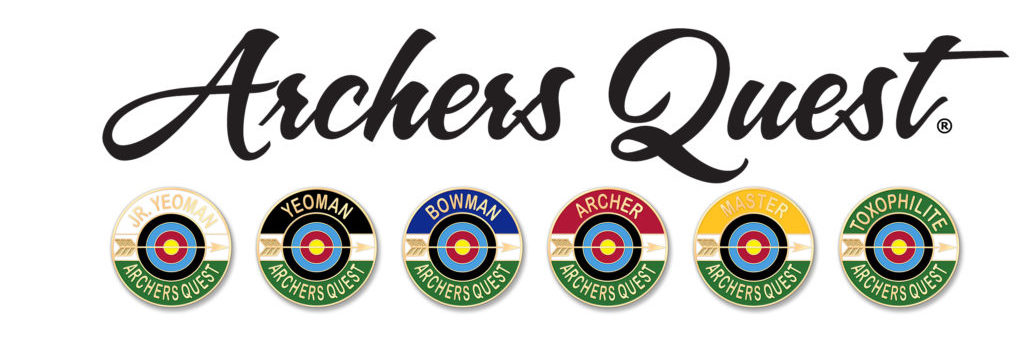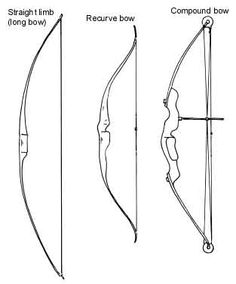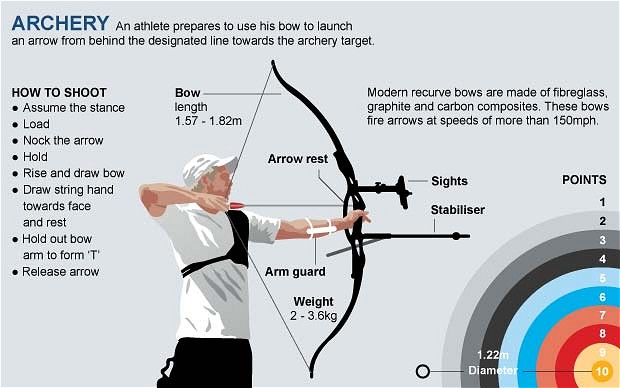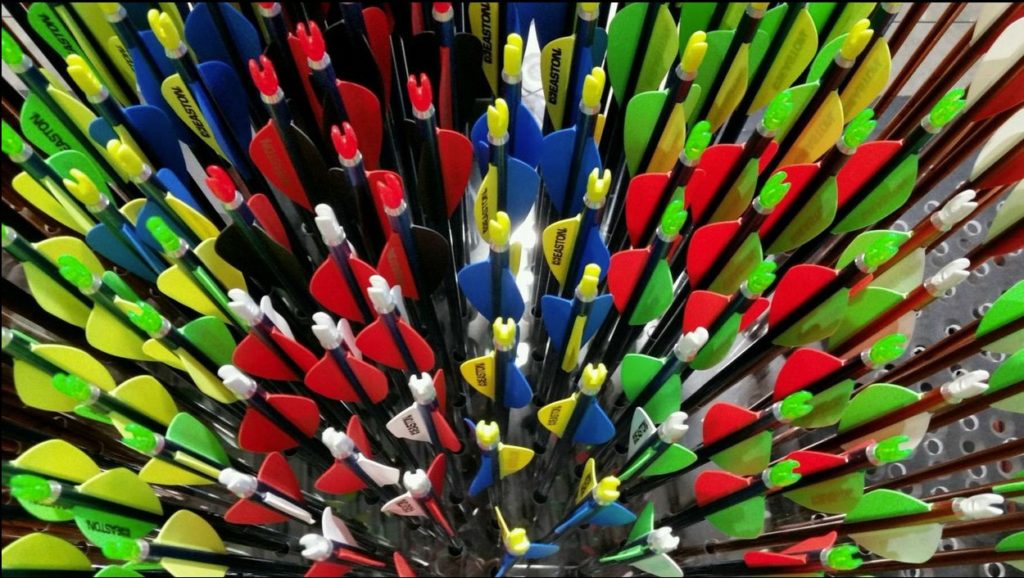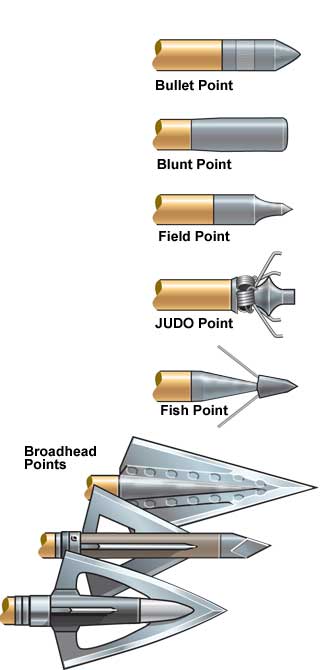Archery Equipment
These are basic definition and descriptions of the types of bows most popular today. This is brief a very brief description at this point in the course so that you can quickly identify and appreciate features. Later on you will explore each of these bow categories in much more detail.
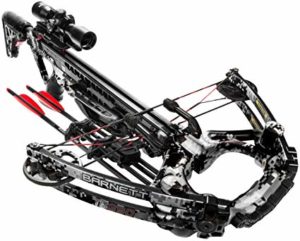
What about the crossbow? It has an important place in archery and history. It shoots a stick out, but is more like a gun than a bow. The Archers Quest program does not include the crossbow due to the lack of skill needed by the user. This video wonderfully explains this and some history behind the importance of the archer. https://youtu.be/LuOm3I-tTFo
Long Bow
The most traditional type of bow is the longbow. These are the bows that most have seen in the old Robin Hood movies.
Famous archers like Howard Hill …
and Fred Bear…

…made archery popular with these bows in the United States.
Modern long bows are laminated strips of wood or of a single stick of wood (called a stave) with a grip and a “bow string”. Some are built with a “rest” to shoot off a shelf. Some may be without a rest, the arrow rests then on top of the bow hand (a shooting glove is normally used).
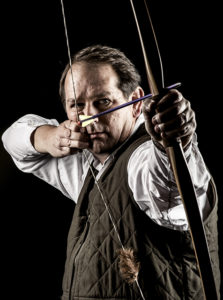 This type of bow remains very popular among archers that prefer a more traditional experience. A long bow offers many exciting challenges to an archer by keeping the equipment and experience as basic as possible. It may be compared in shooting efficiency to shotgun compared to a telescopic rifle.
This type of bow remains very popular among archers that prefer a more traditional experience. A long bow offers many exciting challenges to an archer by keeping the equipment and experience as basic as possible. It may be compared in shooting efficiency to shotgun compared to a telescopic rifle.
Traditional Recurve and Olympic Recurve Bows
The first evolution of the bow was the recurve bow. The recurve is constructed with limbs that have a curve built into them. This special curve stores more energy in a shorter length limb. The result is increased arrow speed and a more compact shooting tool. A recurve can be fashioned from wood or multiple high tech lamination materials. The “riser” also can be manufactured wood, but many competitive modern bows from machined aluminum – like you would see in the Olympics. The riser also provides a shelf for the arrow to rest on – some are mechanically adjustable to provide truer arrow flight. The recurve (take-down style, disassembles for portability) is the bow of choice for those competing on the international level.
Introduction to Archery Compound Bows
The most technologically advanced form of bow of our modern time is the compound bow. The compound bow has an eccentric pulley or cam mounted at the end of each limb tip and was introduced in the 1960’s. Besides much higher arrow speed, compound bows have a unique benefit – reduced amount of weight required to hold a bow at full draw. Unlike the longbow or recurve which become harder to pull as you draw (takes increased force to bend the bow’s “limbs”). The compound bow may have a mechanical let-off of the force required. At a point in the drawing motion, the weight is reduced, or “let off”. This helps the archer remain at full draw. So a stronger bow can be shot with less strength.
This category of bow is more of a telescopic rifle… it can be customized to the shooter to maximize accuracy with sights, custom draw length, and mechanical release of the bow string. This bow can be shot accurately with minimal experience, knowledge, or practice… if tuned correctly to the individual shooting it. It is also the most dangerous to begin shooting without any experience, knowledge or practice… warning: don’t “dry fire” a compound bow or shoot wood arrows through it!
Arrows
Selecting arrows is not difficult; it depends on the type of bow and what you are shooting at. There are charts the manufacturers publish to help specify arrow products to your equipment. The best start is to visit the archery pro shop, see the variety, see how they are constructed, and discuss their purposes. Also, get measured for your “draw length” – it is important that your arrows are long enough for you! To simplify, there are four types of arrow to choose from. Most traditionalists who use longbows prefer shooting cedar wood arrows. Recurve and compound shooters may prefer from aluminum, carbon, Aluminum/Carbon composite, and fiberglass (fishing) depending on your needs.
Warning: don’t start with carbon arrows without understanding how to test if they are damaged. They will splinter! Always twist and flex the “shafts” before shooting to test their soundness.
Parts of Arrow: Know these terms.
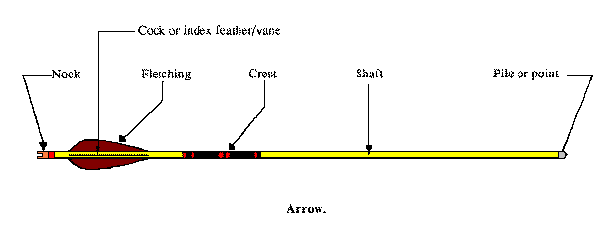
What part engages the bowstring? Why would you use feather fletching compared to plastic vane fletching? How do you orient the arrow so the fletchings do not interfere with the arrow’s flight? The crest is used to identify your arrows. Why is it important to measure the “spine” of the shaft and the length of the overall arrow? What kind of point should you use?
All these topics will be explained through this course, and are good discussion topics on your visitation to a pro shop or archery range later.
Archery Accessories
There are a few accessories that can be used to help make things a little easier on you. A finger-tab or glove helps protect your finger tips from being chaffed as you draw the string back. An armguard is worn on the arm you hold the bow with. It is used to protect your forearm from being struck by the string when you release. A quiver is used to hold your arrows. A chest protector covers a portion of the chest to protect the skin and hold back clothing.
 For compound shooters, a mechanical release is normally used. This device clips to the string and is used instead of your fingers to release the bow string. Once the bow is at full draw, you press a trigger that releases the string.
For compound shooters, a mechanical release is normally used. This device clips to the string and is used instead of your fingers to release the bow string. Once the bow is at full draw, you press a trigger that releases the string.
